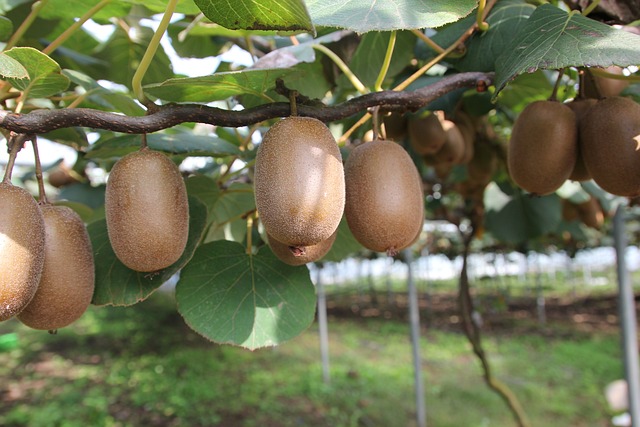Kiwi fruit, also known as Chinese gooseberry, is a nutritious and delicious fruit that can be grown in your own garden. If you’ve ever wondered how to grow kiwi from seeds, you’re in the right place. In this guide, we will walk you through the process of growing kiwi, from seed preparation to planting and caring for your kiwi plants. We’ll also touch on the types of kiwi fruit, and answer some common questions, like how do kiwi plants grow and how to propagate kiwi using cuttings. How to Grow Watermelon here!
Types of Kiwi Fruit
Before diving into the steps of how to grow kiwi, it’s essential to understand the different types of kiwi. There are two main types:
- Fuzzy Kiwi (Actinidia deliciosa): The most common variety found in supermarkets. This type has a brown, hairy skin with bright green flesh inside.
- Hardy Kiwi (Actinidia arguta): A smaller, smooth-skinned variety that is more resistant to cold temperatures. Hardy kiwi is often grown in regions with harsh winters.
Both types can be grown from seeds, but hardy kiwi is better suited for colder climates.
How to Grow Kiwi from Seeds
Step 1: Seed Extraction
To start growing kiwi from seeds, you first need to extract seeds from a ripe kiwi fruit. Follow these steps:
- Choose a ripe kiwi: Select a mature, fully ripened kiwi fruit.
- Extract the seeds: Cut the kiwi in half and scoop out the seeds with a spoon. Place them in a bowl.
- Clean the seeds: Rinse the seeds under cold water to remove the pulp. You can use a fine mesh strainer to separate the seeds from the fruit.
- Dry the seeds: Lay the cleaned seeds on a paper towel and let them dry for a day or two.
Step 2: Germination Process
Once your seeds are dry, it’s time to germinate them.
- Damp Paper Towel Method: Place the seeds on a damp paper towel. Fold the towel over the seeds, and then place it in a plastic ziplock bag. Make sure there is enough moisture, but not too much to avoid mold formation.
- Warm Location: Store the bag in a warm place, such as near a window or on top of the refrigerator, where the temperature stays around 65-75°F (18-24°C).
- Check for Sprouts: After 1-2 weeks, you should start seeing tiny sprouts emerging from the seeds.
Step 3: Planting the Sprouted Seeds
Once your seeds have sprouted, they are ready for planting.
- Prepare the Soil: Kiwi plants prefer well-draining, slightly acidic soil with a pH of 5.0 to 6.5. Use a good-quality potting mix or a blend of compost and sand.
- Plant the Seeds: Fill small pots with soil and plant the sprouted seeds just below the surface (about 1/8 inch deep). Water the soil lightly to keep it moist.
- Provide Light: Place the pots in a sunny location, preferably near a south-facing window or under grow lights. Kiwi plants need plenty of sunlight to thrive.
Step 4: Caring for Kiwi Plants
Once your kiwi seeds have sprouted and been planted, proper care is essential to ensure healthy growth.
- Watering: Keep the soil consistently moist, but not soggy. Overwatering can lead to root rot.
- Fertilizing: Feed your kiwi plants with a balanced fertilizer once they’ve developed a few leaves. Avoid using high-nitrogen fertilizers, as they can lead to excessive leafy growth.
- Pruning: As the plants grow, prune them regularly to encourage healthy growth. Kiwi plants are vigorous climbers, so you may need to provide a trellis or support system.
How Do Kiwi Plants Grow?
Kiwi plants are vigorous vines that can grow up to 20-30 feet in length. They are climbing plants and need support, such as a trellis or a fence, to grow properly. Kiwi plants can take several years to produce fruit, typically around 3-5 years from planting.
Kiwi plants are usually dioecious, meaning they have separate male and female plants. You will need at least one male plant for every 6-8 female plants to ensure pollination and fruit production. Without a male plant, your female kiwi plants will not produce fruit.
Cutting a Kiwi: Propagation by Cuttings
If you prefer not to grow kiwi from seeds, you can also propagate kiwi plants by cutting a kiwi vine. This method is faster and can produce fruit-bearing plants more quickly.
To propagate from cuttings:
- Take a Cutting: In early spring, take a 6-8 inch cutting from a healthy kiwi vine. Make sure the cutting has at least two nodes (small bumps where leaves grow).
- Rooting Hormone: Dip the cut end of the vine in rooting hormone to encourage root growth.
- Plant the Cutting: Place the cutting in a pot filled with well-draining soil, and keep it in a warm, humid location. Water it regularly, and you should see roots forming within a few weeks.
Conclusion
Learning how to grow kiwi from seeds is a rewarding process that can provide you with fresh, homegrown fruit after a few years. Whether you’re interested in growing fuzzy kiwi or hardy kiwi, the process is similar and starts with seed germination. If you’re in a hurry to grow fruit, consider propagating kiwi by cuttings. By understanding how kiwi plants grow, you’ll be on your way to enjoying this delicious fruit from your own garden!
